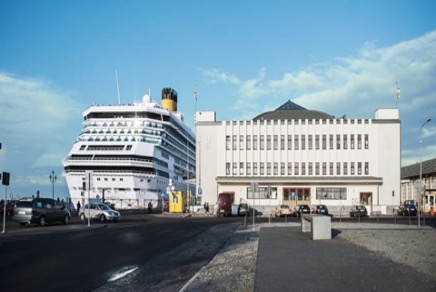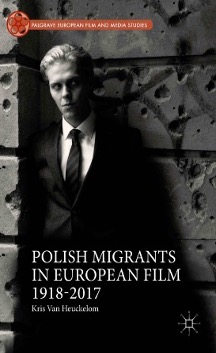What is this project about?
“Migrants on film” is a project that tackles the conceptualization of an exhibition based on the book Polish Migrants in European Film 1918-2017, with the aim to be presented at an ideal venue: Muzeum Emigracji in Gdynia (MEG), in Poland. Therefore, this exhibition would be addressed to a certain public, the Polish local audience. Counting with a list of materials, a list of films, the book and the aforementioned information, the group worked on the preliminary phase of the exhibition by realizing the design and the structure of the entire exhibition.
What is the book and the exhibition about?
The exhibition is based on the book “Polish Migrants in European Film 1918-2017” written by Professor Van Heuckelom. The book accounts for the portrayal of the figure of the Polish Migrant in European cinema. This excludes solely Polish productions, for the target is the portrayal of this figure by foreign countries. The exhibition aims at exploring the representation of international migration on screen and how it has gained prominence and salience in European filmmaking over the past 100 years.
Where is the exhibition happening?

Even though we need to wait for the confirmation of the museum (which is the aim of this project), the location of the exhibition is the Muzeum Emigracji in Gdynia (Poland) that used to be a Marine station, and which has a strong meaning for the Polish migrants. The museum consists of both permanent and temporary exhibition spaces where the exhibition will be held at. The scheduled opening date for the exhibition will be in 2022 but it might be postponed to 2023 depending on the Covid-19 pandemic.
What were the working framework and guidelines?
In order for the proposal to be successful, we had to take into consideration MEG’s guidelines. The time goal was to fit the exhibition in the Spring 2022 season, coinciding with the Gdynia Film Festival. MEG works with them yearly, and for 2022 “Stereotypes” was the chosen topic.
Fortunately, the book had potential to provide content fit for this theme.However, The most challenging aspect of the whole process was to translate the content of an academic book into a content suitable for an exhibition space addressed to a general public. Both, as devices and as languages, differ in significant ways.
How did we approach it?
As each chapter of the book had a different structure based on the historical events that took place over the XX century, we decided to set 3 categories that would structure the exhibition and to analyze the book’s content through that lens. These categories would be: historical context, filmic context and characters/stereotypes.
How was the space of the venue for the exhibition and how did we use it?
MEG’S space for temporary exhibitions includes two different rooms: one is a long hall and the other a squared room. From our perspective, the first room, which we named ‘The Corridor’ , presented the ideal shape to reflect the diachronic approach of the content in the book. The second room, that we named ‘The Square’ , was an open space that invited the visitors to explore, interact and reflect over the content and the yearly theme, ‘stereotypes’.
The division of the exhibition space

The Corridor
We used the longitudinal structure of The Corridor to our advantage by staying truthful to Professor Van Heuckelom’s “Polish Migrants in European Film 1918-2017”. Applying the book’s diachronic approach allowed us to use the major chapters of the book to section off this space. The length of each section is dependent on the acquired film related materials of the corresponding decade. Our general aim for this space was to create a multimedia space for the viewers by giving them both film clips as well as posters, film novels, photographs of famous actors, etc. But also provide for a filmic experience—since the film clips are the central component of the exhibition—for the viewers by darkening the space as much as possible and using screenings on the walls to display the film clips.
The Square


Our idea of The Square was to create a space for the visitors to reflect and potentially connect what they have seen within The Corridor to their own live experiences, memories, stories, etc. The Square is, in contrast to The Corridor’s historical linearity, a space of freedom and movement where the visitors can interact with the provided materials. These materials are not materials of the past but materials of the present, which should help to connect the historical content of The Corridor to our contemporary world. These materials will be works of art—that will be acquired by the museum after an art student contest—interactive tables with quizzes as well as apps that will possibly be created by the museum team. Technologies such as deepfaking and meme generators are proposed in order to create activities based on the content of the exhibition that might help to bring light to its loaded experience, and to foster the interaction of the visitor.
It is important to note that all these materials for The Square are currently mere possibilities for we are still in the preliminary phase of the realization of the exhibition. Which means that the financial and hence physical realizations for these materials have not been considered yet.
Where are we now and where are we going?
Through the entire progress of the project, we were satisfied with the amount of work and the development of incorporating the information of the book into a concept for an exhibition.
We had a meeting with the MEG’team in May to present our conceptualization for the exhibition. They praised our work and wanted to follow our concept for the curation of the exhibition. Although there would be changes due to technical restraints and content curation.
Due to some internal issues of the museum, the next meeting will only start at the beginning of June, professor and project coordinator Kris Van Heuckelom will keep us posted in the long run.
After we created the theoretical concept and design of the exhibition, which is the first part of the project, the remaining work from the second part will shift to the next group that takes over. We believe that it is possible for the next group to continue working on this basis.
